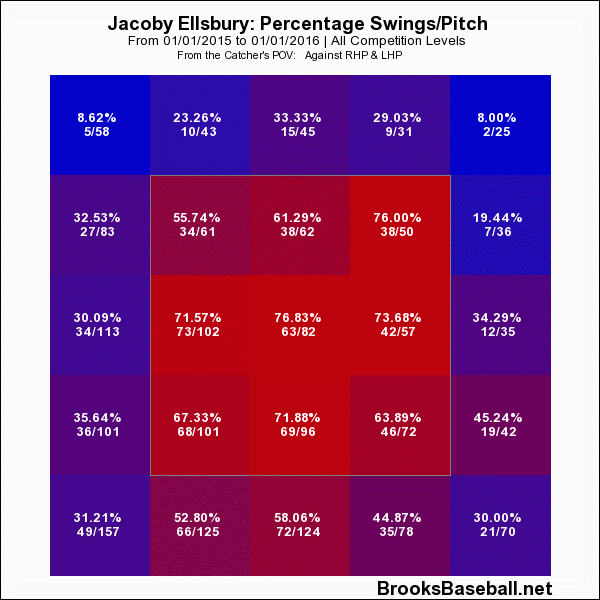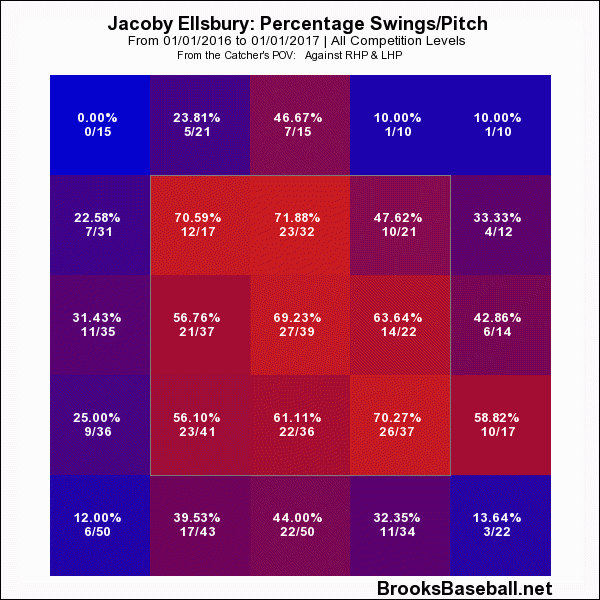The following is a guest post from Carlo Macomber, who goes by CoryWadeDavis in the comments. He’s previous written guest posts about Masahiro Tanaka and Didi Gregorius.

Jacoby Ellsbury’s contract is horrible. Absolutely terrible. Ellsbury is not the type of player that should make over $21 million per season (Cot’s Contracts actually says he makes exactly $21,142,857.15 annually, which is oddly specific). This is not about Ellsbury’s contract, though. Nothing can be done about that at this point, and as Yankees fans, all we can hope is that Ellsbury plays close to his career averages. We should not (and cannot) expect him to perform like a $21 million per year player.
Now that the contract talk is out of the way, let’s look at Jacoby Ellsbury the baseball player. So far this year, Ellsbury has actually been pretty good! After hitting .257/.318/.345 (83 wRC+) in 501 PAs last year, Ellsbury is hitting .280/.344/.415 (108 wRC+) through June 1 (186 PAs) of this season. While his offensive numbers are not anywhere near his anomalous 2011 season when he had a 150 wRC+, this year’s batting line looks incredibly similar to his career .288/.343/.425 (106 wRC+) line. In other words, after being a well below average hitter in 2015, Ellsbury is (so far) back to being the above average hitter he has been for most of his career.
Perhaps the biggest difference between 2015 and 2016 Ellsbury is simply health. Although he did miss about a week with a hip injury this year, Ellsbury has been mostly healthy this season, which is already a noticeable difference from 2015. With this in mind, let’s look to see what Ellsbury has done differently baseball-wise in 2016.
1. He’s hitting the ball harder (for the most part)!
Ellsbury’s hard contact rate this year is at 26.3%, up from 21.1% last year, and very close to his career rate of 25.4%. This is a very good improvement! Interestingly, however, Ellsbury’s soft contact rate is also up. This season he is making soft contact 25.5% of the time, up from 24.1% last year, and well above his career rate of 19.5%. Ellsbury’s BABIP is not particularly high this season at .328, which is in line with his career BABIP of .319 (but higher than last year’s .301).
On the one hand, Ellsbury is making more hard contact than last year (and is now in line with his career average). On the other hand, his soft contact is well above his career rate, yet he is still putting up a typical Ellsbury batting line without an astronomically high BABIP. It will be interesting to see how Ellsbury’s batted ball velocity and BABIP look as the season progresses, but as of right now, it all looks quite solid.
2. He’s striking out less.
Ellsbury’s K% last year was a career-worst 17.2%. A player like Ellsbury, who depends a lot on his speed, needs to put the ball in play as often as possible to be successful. He simply did not do that last season. This year, however, Ellsbury’s K% is down to 15.1%, much closer to his career rate of 13.6%, and nearly identical to his 2013 and 2014 rates (14.5% and 14.6%). It should also be noted that Ellsbury’s 2016 BB% of 7.5% is in line with his career rate of 7.0%. So, while Ellsbury’s hard contact rate is up this year, he is simply making more contact in general than he did last season, leading to a more typical batting line.
3. He’s swinging at better pitches.
Here is a graphic, from the catcher’s perspective, of the percentage of pitches in each location that Ellsbury swung at in 2015.
Obviously, Ellsbury swung at high percentages of pitches in the zone, just as he should. What stands out here, however, is how often he swung at pitches low and out of the zone, and, to a lesser extent, outside and off the place. In general, it is more difficult to hit pitches low and/or outside with authority, which, as evidenced by last seasons’ hard contact rate, Ellsbury did not do very well. On pitches in the bottom five squares of the graphic, Ellsbury hit 14 total line drives, compared to 52 ground balls last season. He also whiffed on 12 of the 21 pitches he swung at in the bottom right square. If Ellsbury is looking to hit the ball hard, which all players should be, laying off more of these low pitches would make sense. Of course, that is much easier said than done in the MLB.
Now, here is the same graphic, except for all pitches Ellsbury has seen this season through June 1.
Clearly, this is a much smaller sample size, but Ellsbury has at least started this season by swinging at fewer pitches low and out of the zone and outside and off the plate. In fact, Ellsbury has swung at a lower percentage of pitches in eight of the nine lowest and furthest outside squares. The only square of those nine with a higher swinging percentage this season is the one in the middle and outside. Ellsbury has continued to swing at pitches both in the zone and inside with high frequency, and these are the pitches that he should be looking to attack in order to hit the ball hard more often.
Offensively, Ellsbury has looked much more like himself so far this season. He is a good, not spectacular, hitter that uses his speed to put pressure on the other team. Last season, after he returned from the DL, Ellsbury looked like an absolute mess at the plate, and he started to swing at poor pitches. It appears that so far this season Ellsbury is being more selective at the plate, which has lead to better contact and fewer strikeouts! It is still possible (maybe likely?) that health is a key factor in his improvement. It is also possible that he made a mechanical adjustment. However, it is evident here that Ellsbury’s ability to swing at better pitches this year has certainly contributed to his success. I imagine that Ellsbury’s resurgence (through two months, don’t forget) is a combination of all three!
4. But what about defense?
While we all know that Ellsbury struggled offensively last season, he actually cost the team several runs defensively as well. Ellsbury has always had a poor arm. Anyone that has ever watched him throw can confirm this. Outfield arm runs, one of the components of the all-encompassing (but, of course, imperfect) defensive metric Ultimate Zone Rating (UZR), says he cost the Yankees 2.1 runs last season, and 2.7 runs this season just because of his poor arm. What is more interesting, however, is that range runs, another component of UZR that measures how well and outfielder can get to balls hit near him, says Ellsbury cost the Yankees 2.0 runs. When all the components are added together, Ellsbury total UZR last season was -3.2 and his UZR per 150 games played was -5.6. This was only his second ever season with a negative UZR.
While his arm has already cost the Yankees 2.7 runs this year, Ellsbury range has improved considerably, and his overall UZR so far this year is +0.6. He is, hypothetically, on track for a UZR per 150 games played of +12.8, which would be a drastic improvement on both 2014 and 2015 but right near is 2013 level. While I do not expect Ellsbury to provide that much defensive value over the course of this season, the evidence is there to suggest that last year was an (injury-related?) aberration, and that Ellsbury is a valuable defensive player. (Last night’s error notwithstanding.)
Overall, Ellsbury is so far revealing that his 2015 season was the polar opposite of his 2011 season. Those two seasons deviate the most from his career averages but in opposite directions. His batting line this season is incredibly close to his career average, and his defense, according to UZR, is returning to a positive level, even if it is not close to his defensive peak. Ellsbury has looked like a good Major League Baseball player again this year, and Yankees fans everywhere should hope that Ellsbury continues to swing at good pitches, chase down fly balls in the outfield, and, of course, remain healthy!


Leave a Reply
You must be logged in to post a comment.